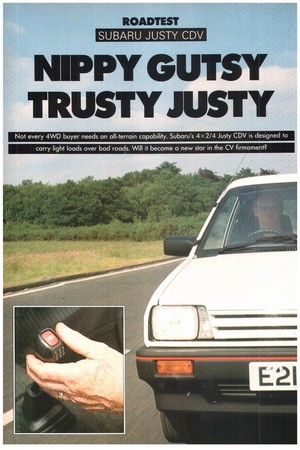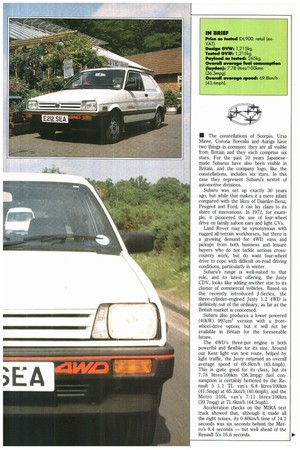NIPPY GUTSY TRUSTY JUSTY
Page 46

Page 47

Page 48

Page 49

If you've noticed an error in this article please click here to report it so we can fix it.
Not every 4WD buyer needs an all-terrain capability. Subaru's 4x2/4 Justy CDV is designed to carry light loads over bad roads. Will it become a new star in the CV firmament?
• The constellations of Scorpio, Ursa Minor, Corona Borealis and Auriga have two things in common: they are all visible from Britain and they each comprise six stars. For the past 10 years Japanesemade Subarus have also been visible in Britain, and the company logo, like the constellations, includes six stars. In this case they represent Subaru's sextet of automotive divisions.
Subaru was set up exactly 30 years ago, but while that makes it a mere infant compared with the likes of Daimler-Benz, Peugeot and Ford, it can lay claim to its share of innovations. In 1972, for example, it pioneered the use of four-wheel drive on family saloon cars and light CVs.
Land Rover may be synonymous with rugged all-terrain workhorses, but there is a growing demand for 4W1) vans and pickups from both business and leisure buyers who do not tackle serious crosscountry work, but do want four-wheel drive to cope with difficult on-road driving conditions, particularly in winter.
Subaru's range is well-suited to that role, and its latest offering, the Justy CDV, looks like adding another star to its cluster of commercial vehicles. Based on the recently introduced J-Series, the three-cylinder-engined lusty 1.2 4WD is definitely out of the ordinary, as far as the British market is concerned.
Subaru also produces a lower powered (40kW) 997cm3 version with a frontwheel-drive option, but it will not be available in Britain for the foreseeable future.
The 4WD's three-pot engine is both powerful and flexible for its size. Around our Kent light van test route, helped by light traffic, the Justy returned an overall average speed of 69.81mrilh (43.4mph). This is quite good for its class, but its 7.78 litres/100km (36.3mpg) fuel consumption is certainly bettered by the Renault 5 Li TL van's 6.8 litres/100Icm (41.5mpg) at 65.3km/h (40.6mph), and the Metro 310L van's 7.11 litres/100km (39.7mpg) at 71.6km/h (44.5mph).
Acceleration checks on the MIRA test track showed that, although it made all the right noises, its 0-80Icrn/h time of 14.2 seconds was six seconds behind the Metro's 8.4 seconds — but well ahead of the Renault 5's 16.6 seconds.
• DRIVELINE
Subaru is a part of the Fuji Heavy Industries giant which also has aircraft and shipbuilding interests, and it manufacturers its own driveline.
The transverse engine is a fairly highrevving 1,189crn3 overhead camshaft petrol unit (Subaru does not offer a diesel version) which produces 50kW (67hp) at 5,600rpm and 97Nm (70Ibft) of torque at 3,600rpm (DIN). It has an aluminium three-valve head (two inlet/one exhaust) and a cast iron engine block.
Subaru combines transistorised ignition with a temperature-controlled air intake and a remotely-positioned fuel supply valve that compensates for changes in altitude by adjusting the fuel/air mixture.
The carburation system produces crisp acceleration and is said to minimise exhaust emissions of pollutants, but it is complex, underlining the importance of the dealers service support. The rest of the engine, however, is designed for ease of maintenance.
The basis of Subaru's four-wheel-drive transmission is its five-speed synchromesh box with a floor-mounted gearshift_ Drive is taken to the front wheels via a 3.7:1 differential. A 1.333:1 transfer box transmits drives to the live rear axle via a two-piece propshaft, then out to independently-sprung wheels through exposed driveshafts.
Selecting four-wheel drive is simplicity itself, by pressing the red button set into the top of the gear shift knob. This activates a solenoid which uses vacuum from the induction manifold to engage drive into the transfer box. Four-wheel drive can engaged without using the clutch, whether stationary or on the move. In fact with the throttle closed, it engages so smoothly that the green warning lights in the centre of the instrument panel are an essential reminder. Depending on the amount of throttle opening, it can be slow to disengage, however, and it comes out rather noisily when reversing, particularly on hills.
Its contribution to safe and sure driving on loose or muddy surfaces is hard to quantify, but on MIRA's 33.3% (1-in-3) test gradient the lusty pulled away quite comfortably in four-wheel drive, while with front-wheel drive only weight transfer caused it to lose traction. Once on the move it climbed the 25% (1-in-4) slope comfortably in 2WD.
Subaru recommends that 4WD is only used where conditions dictate, such as on snow-covered or icy roads, and on mud, dirt or sand. The company stresses that the Justy is not an all-terrain vehicle.
The monocoque-bodied CDV is independently sprung all round, with MacPherson struts, coil springs and an antiroll bar at the front.
It has trailing hydraulic struts at the rear with lower wishbones and coil springs.
The rear wheels are located with trailing arms. These combine with the light rack-and-pinion steering to give the little van extremely good handling in twowheel-drive.
With all four wheels driving, especially on twisting roads, the steering is rather less responsive, but this is a small sacrifice for the sake of improved traction.
• BRAKING
Like most modern saloon cars, the JSeries has ventilated disc brakes at the front with drums at the rear.
When unladen, the Justy's brakes are very responsive — almost too sensitive — and with an evenly distributed load the wheels tended to lock up early and leave long skidmarks on the test track. From 64km/h it pulled up straight and true, but with rather long stopping distances, leaving skidmarks nearly 23 metres in length.
• BODYWORK
The Justy van's car origins are immediately apparent, with part of the car trim still in place at the rear and the side window apertures filled with sealed panels attached by screws.
The tailgate has wash/wipe/heater fittings and is supported by twin struts to a height of 1.76m (69.5in). This means that tall drivers will have to kow-tow when working at the rear to avoid headache as well as backache.
Inside the 1.156inm-long loadspace our load of gravel-filled 15kg plastic bottles butted up against the safety rail that was only secured with only half the number of screws provided for, and soon put paid to the wheel arch's plastic covers. Subaru knows of this weakness and plans to offer a sturdy plastic liner as an optional extra.
The plywood rear floor has cheaplooking plastic covering and, compared with the high-tech power-train, looks like an afterthought from the Third World.
The spare wheel and jack are stored beneath it so a flat tyre will mean unloading at the roadside.
• CAB COMFORT
At the front, the Justy's car-like interior is far from sumptuous, but the contoured seats are well-trimmed and comfortable enough for long journeys. Its carpeted interior is quiet too, with noise levels that never rise above 72dB(A).
Instruments are grouped tidily with the speedo and rev counter either side of the fuel, coolant and temperature gauges and the car-outline display that serves as an all-wheel-drive indicator.
Neat tiers of switches, a la Roadrunner, are placed on either side, with wipers to the left and lights on the right. The only stalk switch is for the direction indicators.
It looks tidy enough but, like so many Japanese car instrument panels, has a cheap, plasticky look to it. In this case the sporty little steering wheel obscures the 0-641cm/h side of the speedo.
Despite its wide doors, side visibility is not too good on acute turns at junctions, but the van's light steering makes it very easy to manoeuvre broadside-on to gain better views.
• SUMMARY
With only 0.93m3 (33f13) of cube and a mere 265kg (5841b) payload, the Justy is only likely to attract the attention of market gardeners, florists or leisure users. It will certainly not appeal to the yuppie element as it lacks height, a sun roof and side views into the rear.
Compared with the Metro's £4,210, the Peugeot 205's £4,360, the Renault 5's 24,460 — and especially the £2,916 of the spartan Yugo van — the Subaru van's £4,900 looks prohibitive, but there is more to the Justy than its sporty growl.
Its willing little three-cylinder engine is nimble through the gears, the van handles well and it is easy to drive in two or four-wheel-drive.
Subaru's 2/4 x 4 MV pickup is well known to tree surgeons, farmers and sporting enthusiasts alike, so the Justy has a reputable lineage. .
The 1.2 4W1) van will safeguard daily deliveries in winter and, despite unspectacular braking on the test track, makes a positive contribution to driving safety.


















































